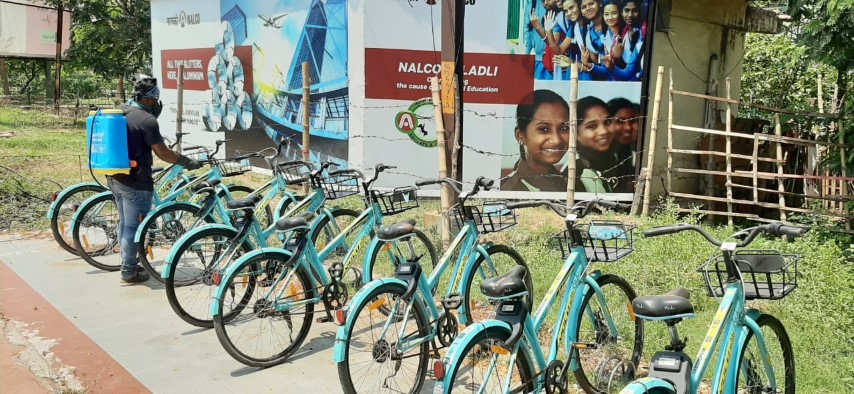Avilash Roul
Mo Cycle as a public bike sharing system (PBS) was introduced in Bhubaneswar November 26, 2018. The objective of Mo Cycle was to offer a sustainable and affordable alternative for short trips or ‘first and last mile’ connectivity. Unfortunately, neither it has emerged as an affordable alternative for short trips, nor integrated into the city transport system.
Cycling as a part of urban mobility in Bhubaneswar can be traced back to the early 2000s. The Works Department mooted a cycle lane on the Jaydev Vihar-Nandankanan route. Similarly a cycle lane of 3.5 metre width was developed from OMFED Chowk to the East Coast Railway office. While such ad-hoc arrangements were made during the 2000s, it was the Bhubaneswar Smart City Limited (BSCL) which adopted cycling as an integral part of the city through Mo Cycle.
In its submission of Bhubaneswar Smart City Proposal (SCP) in February 2015, the BSCL anchored on a child-friendly city providing accessible, safe, inclusive and vibrant public places and quality of urban life. Also, the Union government had put a condition that bicycles must be an eligible component for funding under the Atal Mission for Rejuvenation and Urban Transformation (AMRUT) for smart cities. Thus, BSCL opted for a `6-crore public financed but hybrid public-private-partnership (PPP) model with multiple operators (three private operators) – Yulu, Yaana and Hero Hexi.
It is believed that the lure for the Union government’s financial support and to fulfil a requirement to qualify as a smart city, the city administration added PBS in a hurry without proper due diligence. The laying down of its infrastructure in three days prior to the FIH Men’s Hockey World Cup in 2018 had baffled all citizens except those who were in charge. Was it a collective decision to canvass Bhubaneswar as a destination city with PBS when the mega hockey event opened?
While the so-called PPP model collapsed in less than 18 months, partly the pandemic is to be blamed for Mo Cycle’s misfortune or agony showcasing near various bus stops across the city. That the city administration couldn’t maximise the cycling facilities during the pandemic is altogether another story of short-sightedness. The bilateral agencies that are extending finance and knowledge support to the Union government and state governments on sustainable transport are hell bent on assessing the success of PBS in terms of business model only. The success of PBS in cities in India lies beyond its limited business model.
Bicycle sharing emerged in Europe in the 1960s. Since then, there has been remarkable transformation of its service offerings and geographical outreach. Since the first generation of PBS in Europe, PBS have rapidly evolved and adapted to changing environmental, technological and economic factors.
Meanwhile, the Union government, through its National Urban Transport Policies of 2006 and 2014, and National Urban Renewal Mission (NURM) and Smart City Initiative, prioritises Non-Motorised Transport (NMT), focusing on planning for people rather than vehicles. Walking, cycling and cycle rickshaws, as NMT, are preferably customised into Indian cities both by evolving necessity and design.
Cities across the world have been ramping up their cycling systems for smooth movement of people in response to the pandemic and thereafter. Neither BSCL nor Bhubaneswar Municipal Corporation (BMC) considered reviving Mo Cycle during the pandemic when it was most required. If at all the city wants to adopt a long term, successful, people friendly, transparent PBS, we need to consider some of the aspects which were missed in Mo Cycle.
First of all, consult with city dwellers from all sections in a transparent manner to co-create the PBS. Set aside dedicated space for constructing a permanent cycle track for a few kilometres in the most feasible intersections. Don’t implement cycle infrastructure as an add-on, as is the case in Bhubaneswar. It may be advisable to adopt Dutch Guidelines for Cycle Infrastructure.
Cycling culture evolves gradually through the engagement of citizens rather than top-down bureaucrat-consultant model of governance as it is in the case of Mo Cycle. With awareness and education on cycling, the state must initiate steps to develop an NMT policy. PBS must not be considered as a one-time investment project.
Mo Cycle’s premature collapse is unwarranted and uncalled for. Cycling can be an effective alternative to public transport in the post-pandemic world. Albert Einstein once wrote “Life is like riding a bicycle, to keep your balance, you must keep moving.” Bhubaneswar too will have to perform a balancing act for a long time to come. City administration must allow individuals to contribute their share of reducing carbon emissions by maximising their trips in cycles rather than burning fossil fuels. For that, right kind of cycle infrastructure backed by a law for NMT must be a priority. Are we ready for PBS?
The writer is Guest Professor/Principal Scientist, IIT Madras. Views are personal.
